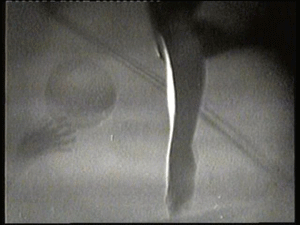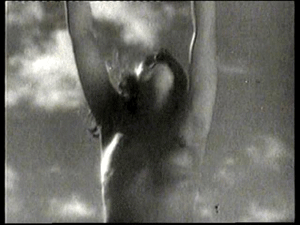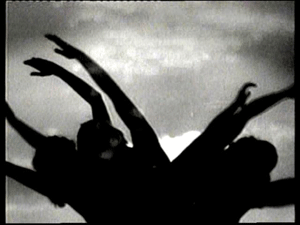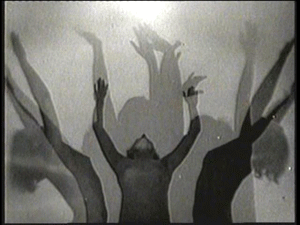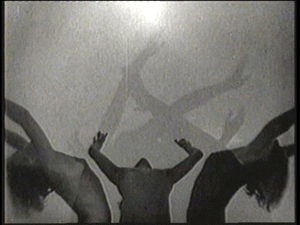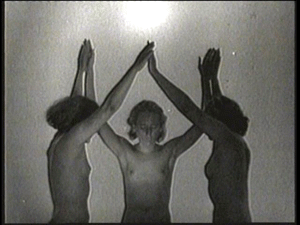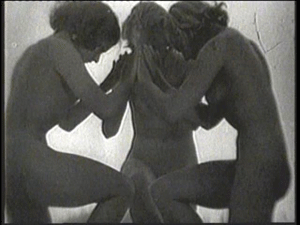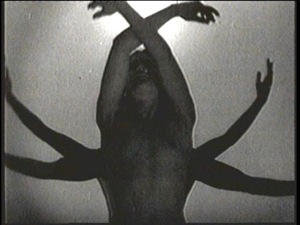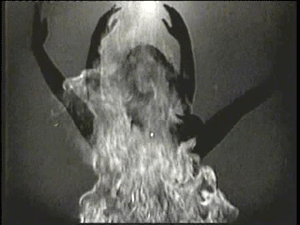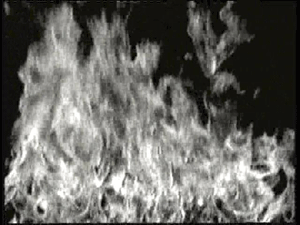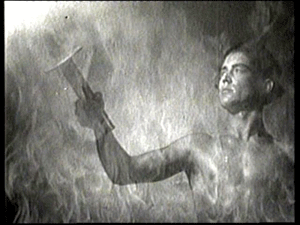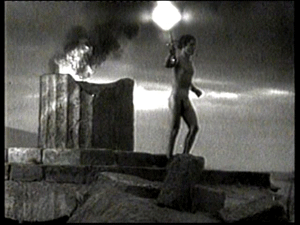The “tantric female sacrifice”But are we really justified in speaking of a “tantric female sacrifice”? We shall attempt to find an answer to this difficult question. Fundamentally, the Buddhist tantric distinguishes three types of sacrifice: the outer, the inner and the secret. The “outer sacrifice” consists of the offering to a divinity, the Buddhas, or the guru, of food, incense, butter lamps, perfume, and so on. For instance in the so-called “mandala sacrifice” the whole universe can be presented to the teacher, in the form of a miniature model, whilst the pupil says the following. “I sacrifice all the components of the universe in their totality to you, O noble, kind, and holy lama!” (Bleichsteiner, 1937, p. 192)
In the “inner sacrifice” the pupil (Sadhaka) gives his guru, usually in a symbolic act, his five senses (sight, hearing, smell, taste, and touch), his states of consciousness, and his feelings, or he offers himself as an individual up to be sacrificed. Whatever the master demands of him will be done — even if the sadhaka must cut the flesh from his own limbs, like the tantric adept Naropa.
Behind the “secret sacrifice” hides, finally, a particular ritual event which attracts our especial interest, since it is here that the location of the “tantric female sacrifice” is to be suspected. It concerns — as can be read in a modern commentary upon the Kalachakra Tantra — “the spiritual sacrifice of a dakini to the lama” (Henss, 1985, p. 56). Such symbolic sacrifices of goddesses are all but stereotypical of tantric ceremonies. “The exquisite bejeweled woman ... is offered to the Buddhas” (Gäng, 1988, p. 151), as the Guhyasamaja Tantra puts it. Often eight, sometimes sixteen, occasionally countless “wisdom girls” are offered up in “the holy most secret of offerings” (quoted by Beyer, 1978, p. 162)
The sacrifice of samsara:A sacrifice of the feminine need not be first sought in Tantrism, however; rather it may be found in the logic of the entire Buddhist doctrine. Woman per se– as Buddha Shakyamuni repeatedly emphasized in many of his statements — functions as the first and greatest cause of illusion (maya), but likewise as the force which generates the phenomenal world (samsara). It is the fundamental goal of every Buddhist to overcome this deceptive samsara. This world of appearances experienced as feminine, presents him with his greatest challenge. “A woman”, Nancy Auer Falk writes, “was the veritable image of becoming and of all the forces of blind growth and productivity which Buddhism knew as Samsara. As such she too was the enemy — not only on a personal level, as an individual source of temptation, but also on a cosmic level” (Gross, 1993, p. 48). In this misogynist logic, it is only after the ritual destruction of the feminine that the illusory world (maya) can be surmounted and transcended.
Is it for this reason that maya (illusion), the mother of the historical Buddha, had to die directly after giving birth? In her early death we can recognize the original event which stands at the beginning of the fundamentally misogynist attitude of all Buddhist schools. Maya both conceived and gave birth to the Sublime One in a supernatural manner. It was not a sexual act but an elephant which, in a dream, occasioned the conception, and Buddha Shakyamuni did not leave his mother’s body through the birth canal, but rather through her hip. But these transfeminine birth myths were not enough for the tellers of legends. Maya as earthly mother had, on the path to enlightenment of a religion which seeks to free humanity from the endless chain of reincarnation, to be proclaimed an “illusion” (maya) and destroyed. She receives no higher accolade in the school of Buddha, since the woman — as mother and as lover — is the curse which fetters us to our illusory existence.
Already in Mahayana Buddhism, the naked corpse of a woman was considered as the most provocative and effective meditation object an initiand could use to free himself from the net of Samsara. Inscribed in the iconography of her body were all the vanities of this world. For this reason, he who sank bowed over a decaying female body could achieve enlightenment in his current life. To increase the intensity of the macabre observation, it was usual in several Indian monastic orders to dismember the corpse. Ears, nose, hands, feet, and breasts were chopped off and the disfigured trunk became the object of contemplation. “In Buddhist context, the spectacle of the mutilated woman serves to display the power of the Buddha, the king of the Truth (Dharma) over Mara, the lord of the Realm of Desire.”, writes Elizabeth Wilson in a discussion of such practices, “By erasing the sexual messages conveyed by the bodies of attractive women through the horrific spectacle of mutilation, the superior power of the king of Dharma is made manifest to the citizens of the realm of desire.” (Wilson, 1995, p. 80).
In Vajrayana, the Shunyata doctrine (among others) of the nonexistence of all being, is employed to conduct a symbolic sacrifice of the feminine principle. Only once this has evaporated into a “nothing” can the world and we humans be rescued from the curse of maya (illusion). This may also be a reason why the “emptiness” (shunyata), which actually by definition cannot possess any characteristics, is hypostasized as feminine in the tantras. This becomes especially clear in the Hevajra Tantra. In staging of the ritual we encounter at the outset a real yogini (karma mudra) or at least an imagined goddess (inana mudra), whom the yogi transforms in the course of events into a “nothing” using magic techniques. By the end the tantric master has completely robbed her of her independent existence, that is, to put it bluntly, she no longer exists. “She is the Yogini without a Self” (Farrow and Menon, 1992, pp. 218–219). Thus her name, Nairatmya, literally means ‘one who has no self, that is, non-substantial’ (Farrow and Menon, 1992, p. 219). The same concept is at work when, in another tantra, the “ultimate dakini” is visualized as a “zero-point” and experienced as “indivisible pleasure and emptiness” (Dowman, 1985, p. 74). Chögyam Trungpa sings of the highest “lady without being” in the following verses:
Always present, you do not exist ...
Without body, shapeless, divinity of the true.
-- Trungpa, 1990, p. 40
Only her bodilessness, her existential sacrifice and her dissolution into nothing allow the karma mudra to transmute into the maha mudra and gynergy to be distilled out of the yogini in order to construct the feminine ego of the adept with this “stuff”. “Relinquishing her form [as] a woman, she would assume that of her Lord” the Hevajra Tantra establishes at another point (Snellgrove, 1959, p. 91).
The maha mudra has, it is said, an “empty body” (Dalai Lama I, 1985, p. 170). What can be understood by this contradictory metaphor? In his commentary on the Kalachakra Tantra, Ngawang Dhargyey describes how the “empty body” can only be produced through the destruction of all the “material” elements of a physical, natural “body of appearance”. In contrast to such, “their bodies are composed simply of energy and consciousness” (Dhargyey, 1985, p. 131). The physical world, sensuality, matter and nature — considered feminine in not just Buddhism — thus become pure spirit in an irreconcilable opposition. But they are not completely destroyed in the process of their violent spiritualization, but rather “sublated” in the Hegelian sense, namely “negated” and “conserved” at the same time; they are — to make use of one of the favorite terms of the Buddhist evolutionary theorist, Ken Wilber — “integrated”. This guarantees that the creative feminine energies are not lost following the material “dissolution” of their bearers, and instead are available solely to the yogi as a precious elixir. A sacrifice of the feminine as an autonomous principle must therefore be regarded as the sine qua non for the universal power of the tantric master. These days this feminine sacrifice may only be performed entirely in the imagination. But this need not have always been the case.
“Eating” the gynergy:But Vajrayana is concerned with more than the performance of a cosmic drama in which the feminine and its qualities are destroyed for metaphysical reasons. The tantric recognizes a majority of the feminine properties as extremely powerful. He therefore has not the slightest intention of destroying them as such. In contrast, he wishes to make the feminine forces his own. What he wants to destroy is solely the physical and mental bearer of gynergy — the real woman. For this reason, the “tantric female sacrifice” is of a different character to the cosmogonic sacrifice of the feminine of early Buddhism. It is based upon the ancient paradigm in which the energies of a creature are transferred to its killer. The maker of the sacrifice wants to absorb the vital substance of the offering, in many cases by
consuming it after it has been slaughtered. Through this he not only “integrates” the qualities of the killed, but also believes he may outwit death, by feeding upon the body and soul of the sacrificial victim.
In this connection the observation that world wide the sacred sacrifice is contextually linked with food and eating, is of some interest. It is necessary to kill plants and animals in order to nourish oneself. The things killed are subsequently consumed and thus appear as a necessary condition for the maintenance and propagation of life. Eating increases strength, therefore it was important to literally incorporate the enemy. In cannibalism, the eater integrates the energies of those he has slaughtered. Since ancient humans made no basic distinction between physical, mental or spiritual processes, the same logic applied to the “eating” of nonbodily forces. One also ate souls, or prana, or the élan vital.
In the Vedas, this general “devouring logic” led to the conception that the gods nourished themselves from the life fluids of ritually slaughtered humans, just as mortals consume the bodies of animals for energy and nourishment. Thus, a critical-rational section of the Upanishads advises against such human sacrifices, since they do not advance individual enlightenment, but rather benefit only the blood-hungry supernatural beings.
Life and death imply one another in this logic, the one being a condition for the other. The whole circle of life was therefore a huge sacrificial feast, consisting of the mutual theft and absorption of energies, a great cosmic dog-eat-dog. Although early Buddhism gave vent to keen criticism of the Vedic rites, especially the slaughter of people and animals, the ancient sacrificial mindset resurfaces in tantric ritual life. The “devouring logic” of the Vedas also controls the Tantrayana. Incidentally, the word tantra is first found in the context of the Vedic sacrificial gnosis, where it means ‘sacrificial framework’ (Smith, 1989, p. 128).
Sacred cannibalism was always communion, holy union with the Spirit and the souls of the dead. It becomes Eucharistic communion when the sacrifice is a slaughtered god, whose followers eat of him at a supper. God and man are first one when the man or woman has eaten of the holy body and drunk the holy blood of his or her god. The same applies in the relation to the goddess. The tantric yogi unites with her not just in the sexual act, but above all through consuming her holy gynergy, the magical force of maya. Sometimes, as we shall see, he therefore drinks his partner’s menstrual blood. Only when the feminine blood also pulses in his own veins will he be complete, an androgyne, a lord of both sexes.
To gain the “gynergy” for himself, the yogi must “kill” the possessor of the vital feminine substances and then “incorporate” her. Such an act of violence does not necessarily imply the real murder of his mudra, it can also be performed symbolically. But a real ritual murder of a woman is by like measure not precluded, and it is not surprising that occasional references can be found in the Vajrayana texts which blatantly and unscrupulously demand the actual killing of a woman. In a commentary on the Hevajra Tantra, at a point where a lower-caste wisdom consort (dombi) is being addressed, states bluntly, “I kill you, O Dombi, I take your life!” (Snellgrove, 1987, vol. 1, p. 159).
Sati or the sacred inaugural sacrifice:In any case, in all the rituals of the Highest Tantra initiations a symbolic female sacrifice is set in scene. From numerous case studies in cultural and religious history we are aware that an “archaic first event”, an “inaugural sacred murder” may be hiding behind such symbolic stagings. This “original event”, in which a real wisdom consort was ritually killed, need in no sense be consciously acknowledged by the following generations and cult participants who only perform the sacrifice in their imaginations or as holy theater. As the French anthropologist René Girard convincingly argues in his essay on Violence and the Sacred, the original murderous deed is normally no longer fully recalled during later symbolic performances. But it can also not become totally forgotten. It is important that the violent origin of their sacrificial rite be shrouded in mystery for the cult participant. “To maintain its structural force, the inaugural violence must not make an appearance”, claims Girard (Girard, 1987, p. 458). Only thus can the participants experience that particular emotionally laden and ambivalent mixture of crime and mercy, guilt and atonement, violence and satisfaction, shuddering and repression which first lends the numinous aura of holiness to the cult events.
It thus seems appropriate to examine Tantric Buddhism for signs of such an “inaugural sacrifice”. In this connection, we would like to draw attention to a Shiva myth, which has nonetheless had an influence on the history of the Buddhist tantras.
In the mythical past, Sati was the consort of the god Shiva. When her father Daksa was planning a great sacrificial feast, he failed to invite his daughter and son-in-law. Unbidden, Sati nonetheless attended the feast and was deeply insulted by Daksa. Filled with shame and anger she threw herself upon the burning sacrificial altar and died. (In another version of the story she alone was invited and cremated herself when she heard that her spouse was barred from the feast.) Shiva, informed of the death of his wife, hurried at once to the scene of the tragedy and decapitated Daksa. He then took the body of his beloved Sati, laid her across his shoulders and began a funeral procession across all India. The other gods wanted to free him from the corpse and set about dismembering it, piece by piece, without Shiva noticing what they were doing.
The places where the fragments fell were destined to become holy sites known as Shakta pithas. There where Sati’s vulva came to land the most sacred location was established. In some texts there is talk of 24, in others of 108 pithas, the latter being the holy number of Buddhism. At Sati’s numerous graves cemeteries were set up forthwith, at which the people cremated their dead. Around these locations developed a many-sided, and as we shall see, extremely macabre death culture, which was nurtured by Tantrics of all schools (including the Buddhist variety).
In yet another version of the Sati legend, the corpse of Shiva’s wife contained a “small cog — a symbol of manifest time -, [which] destroyed the body of the goddess from the inside out. ... [It] was then dismembered into 84 fragments which fell to earth at the various holy sites of India” (Hutin, 1971, p. 67). This is indeed a remarkable variant on the story, since the number of famous Maha Siddhas (Grand Sorcerers), who in both the Buddhist and Hindu tradition introduced Tantrism to India as a new religious practice, is 84. These first Tantrics chose the Shakta pithas as the central locations for their rituals. Some of them, the Nath Siddhas, claimed Sati had sacrificed herself for them and had given them her blood. For this reason they clothed themselves in red robes (White, 1996, p. 195). Likewise, one of the many Indian cemetery legends tells how five of the Maha Siddhas emerged from the cremated corpse of a goddess named Adinatha (White, 1996, p. 296). It can be assumed that this is also a further variation on the Sati legend.
It is not clear from the tale whether the goddess committed a sacrificial suicide or whether she was the victim of a cruel murder. Sati’s voluntary leap into the flames seems to indicate the former; her systematic dismemberment the latter. A “criminological” investigation of the case on the basis of the story alone, i.e., without reference to other considerations, is impossible, since the Sati legend must itself be regarded as an expression of the mystifying ambivalence which, according to René Girard, veils every inaugural sacrifice. All that is certain is that all of the originally Buddhist (!) Vajrayana’s significant cult locations were dedicated to the dismembered Hindu Sati.
Earlier, however, claims the Indologist D. C. Sircar, famous relics of the “great goddess” were said to be found at the Shakta pithas. At the heart of her cult stood the worship of her yoni (‘vagina’) (Sircar, 1973, p. 8). We can only concur with this opinion, yet we must also point out that the majority of the matriarchal cults of which we are aware also exhibited a phallic orientation. Here the phallus did not signalize a symbol of male dominance, but was instead a toy of the “great goddess”, with which she could sexual-magically manipulate men and herself obtain pleasure.
We also think it important to note that the practices of Indian gynocentric cults were in no way exempt from sacrificial obsession. In contrast, there is a comprehensive literature which reports the horrible rites performed at the Shakta pithas in honor of the goddess Kali. Her followers bowed down before her as the “consumer of raw meat”, who was constantly hungry for human sacrifices. The individuals dedicated to her were first fed up until they were sufficiently plump to satisfy the goddess’s palate. On particular feast days the victims were decapitated in her copper temple (Sircar, 1973, p. 16).
Naturally we can only speculate that the “dismemberment of the goddess” in the Sati myth might be a masculine reaction to the original fragmentation of the masculine god by the gynocentric Kali. But this murderous reciprocity must not be seen purely as an act of revenge. In both cases it is a matter of the increased life energy which is to be achieved by the sacrifice of the opposite sex. In so doing, the “revolutionary” androcentric yogis made use of a similar ritual praxis and symbolism to the aggressive female followers of the earlier matriarchy, but with reversed premises. For example, the number 108, so central to Buddhism, is a reminder of the 108 names under which the great goddess was worshipped (Sircar, 1973, p. 25).
The fire sacrifice of the dakini:The special feature of Greek sacrificial rites lay in the combination of burning and eating, of blood rite and fire altar. In pre-Buddhist, Vedic India rituals involving fire were also the most common form of sacrifice. Humans, animals, and plants were offered up to the gods on the altar of flame. Since every sacrifice was supposed to simulate among other things the dismemberment of the first human, Prajapati, it always concerned a “symbolic human sacrifice”, even when animal or plant substitutes were used.
At first the early Buddhists adopted a highly critical attitude towards such Vedic practices and rejected them outright, in stark opposition to Vajrayana later, in which they were to regain central significance. Even today, fire pujas are among the most frequent rituals of Tantric Buddhism. The origin of these Buddhist “flame masses” from the Vedas becomes obvious when it is noted that the Vedic fire god Agni appears in the Buddhist tantras as the “Consumer of Offerings”. This is even true of the Tibetans. In this connection, Helmut von Glasenapp describes one of the final scenes from the large-scale Kalachakra ritual, which the Panchen Lama performed in Beijing 1932: A “woodpile was set alight and the fire god invited to take his place in the eight-leafed lotus which stood in the middle of the fireplace. Once he had been offered abundant sacrifices, Kalachakra was invited to come hither from his mandala and to become one with the fire god” (von Glasenapp, 1940, p. 142). Thus the time god and the fire unite.
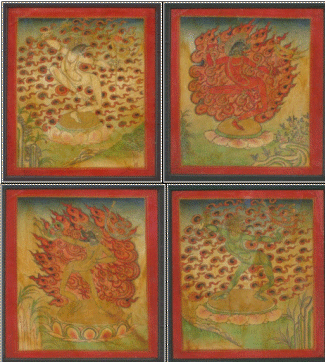 Burning Dakinis
Burning DakinisThe symbolic burning of “sacrificial goddesses” is found in nearly every tantra. It represents every possible characteristic, from the human senses to various states of consciousness. The elements (fire, water, etc.) and individual bodily features are also imagined in the form of “sacrificial goddesses”. With the pronouncement of a powerful magic formula they all perish in the fire. In what is known as the Vajrayogini ritual, the pupil sacrifices several inana mudras to a red fire god who rides a goat. The chief goddess, Vajrayogini, appears here with “a red-colored body which shines with a brilliance like that of the fire of the aeon” (Gyatso, 1991, p. 443). In the Guhyasamaya Tantra the goddesses even fuse together in a fiery ball of light in order to then serve as a sacrifice to the Supreme Buddha. Here the adept also renders malignant women harmless through fire: “One makes the burnt offerings within a triangle. ... If one has done this three days long, concentrating upon the target of the women, then one can thus ward them off, even for the infinity of three eons” (Gäng, 1988, p. 225). A “burning woman” by the name of Candali plays such a significant role in the Kalachakra initiations that we devote an entire chapter to later. In this context we also examine the “ignition of feminine energy”, a central event along the sexual magic initiation path of Tantrism.
In Buddhist iconography, the tantric initiation goddesses, the dakinis are represented dancing within a fiery circle of flame. These are supernatural female beings encountered by the yogi on his initiatory journey who assist him in his spiritual development, but with whom he can also fall into serious conflict. Translated, dakini means “sky-going one” or “woman who flies” or “sky dancer”. (Herrmann-Pfand, 1996, pp. 68, 38). In Buddhism the name appeared around 400 C.E.
The German Tibetologist Albert Grünwedel was his whole life obsessed with the idea that the “heaven/sky walkers” were once human “wisdom companions”, who, after they had been killed in a fire ritual, continued to function in the service of the tantric teachings as female spirit beings (genies). He saw in the dakinis the “souls of murdered mudras” banished by magic, and believed that after their sacrificial death they took to haunting as Buddhist ghosts (Grünwedel, 1933, p. 5). Why, he asked, do the dakinis always hold skull cups and cleavers in their hands in visual representations? Obviously, as can be read everywhere, to warn the initiands against the transient and deceptive world of samsara and to cut them off from it. But Grünwedel sees this in a completely different light: For him, just as the saints display the instruments of their martyrdom in Christian iconography, so too the tantric goddesses demonstrate their mortal passing with knives and skulls; like their European sisters, the witches, with whom they have so much in common, they are to be burnt at the stake (Grünwedel, Kalacakra III, p. 41) Grünwedel traces the origin of this female sacrifice back to the marked misogyny of the early phase of Buddhism: “The insults [thrown at] the woman sound dreadful. ... The body of the woman is a veritable cauldron of hell, the woman a magical form of the demons of destruction” (Grünwedel, 1924, vol. 2, p. 29).
One could well shrug at the speculations of this German Tibetologist and Asian researcher. As far as they are understood symbolically, they do not contradict tantric orthodoxy in the slightest, which even teaches the destruction of the “external” feminine as an article of faith. As we have seen, the sacrificial goddesses are burnt symbolically. Some tantras even explicitly confirm Grünwedel’s thesis that the dakinis were once “women of flesh and blood”, who were later transformed into “spirit beings” (Bhattacharyya, 1982, p. 121). Thus she was sacrificed as a karma mudra, a human woman in order to then be transformed into an inana mudra, an imaginary woman. But the process did not end here, then the inana mudra still had an existence external to the adept. She also needed to be “sacrificed” in order to create the “inner woman”, the maha mudra. A passage from the Candamaharosana Tantra thus plainly urges the adept: “Threaten, threaten, kill, kill, slay slay all Dakinis!” (quoted by George, 1974, p. 64)
But what is the intent behind a fiery dakini sacrifice? The same as that behind all the other tantric rituals, namely the absorption of gynergy upon which to found the yogi’s omnipotence. Here the longed-for feminine elixir has its own specific names. The adept calls it the “heart blood of the dakini”, the “essence of the dakini’s heart”, the “life-heart of the dakini” (Herrmann-Pfand, 1992, p. 342). “Via the ‘conversion’ the Dakinis become protectors of the religion, once they have surrendered their ‘life-heart’ to their conqueror”, a tantra text records (Herrmann-Pfand, 1992, p. 204).
This “surrender of the heart” can often be brutal. For example, a Tibetan story tells of how the yogini Magcig declares that she is willing for her breast to be slit open with a knife — whether in reality or just imagination remains unclear. Her heart was then taken out, “and whilst the red blood — drip, drip — flowed out”, laid in a skull bowl. Then the organ was consumed by five dakinis who were present. Following this dreadful heart operation Magcig had transformed herself into a dakini (Herrmann-Pfand, 1992, p. 164). As macabre as this story is, on the other hand it shows that the tantric female sacrifice need not necessarily be carried out against the will of woman to be sacrificed. In contrast, the yogini often surrenders her heart-blood voluntarily because she loves her master. Like Christ, she lets herself be crucified for love. But her guru may never let this love run free. He has a sacred duty to control the feelings of the heart, and the power to manipulate them.
In the dakini’s heart lies the secret of enlightenment and thus of universal power. She is the “Queen of Hearts”, who — like Diana, Princess of Wales — must undergo a violent “sacrificial death” in order to then shine as the pure ideal of the monarchy (the “autocratic rule” of the yogis). Lama Govinda also makes reference to a fiery sacrificial apotheosis of the dakini when he proclaims in a vision that all feminine forces are concentrated in the sky walkers, “until focused on a point as if through a lens they kindle to a supreme heat and become the holy flame of inspiration which leads to perfect enlightenment” (Govinda, 1991, p. 231). It need not be said that here the inspiration and enlightenment of the male tantra master alone is meant and not that of his female sacrifice.
VajrayoginiThe “tantric female sacrifice” has found a sublime and many-layered expression in what is known as the “Vajrayogini rite”, which we would like to examine briefly because of its broad distribution among the Tibetan lamas. Vajrayogini is the most important female divine figure in the highest yogic practices of Tibetan Buddhism. The goddess is worshipped as, among other things, “Mistress of the World”, the “Mother of all Buddhas”, “Queen of the Dakinis”, and a “Powerful Possessor of Knowledge”. Her reverential cult is so unique in androcentric Lamaism that a closer examination has much to recommend it. In so doing we draw upon a document on Vajrayogini praxis by the Tibetan lama Kelsang Gyatso.
This tantric ritual, centered upon a principal female figure, begins like all others, with the pupil’s adoration of the guru. Seated upon two cushions which represent the sun and moon, the master holds a vajra and a bell in his hands, thus emphasizing his androgyny and transsexual power.
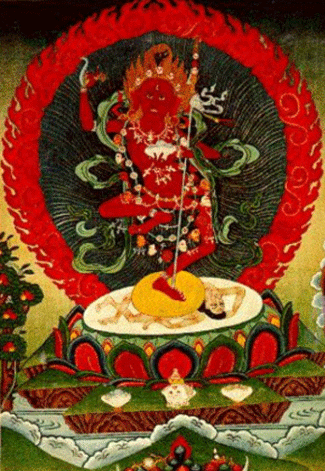 Vajra Yogini in the burning circle
Vajra Yogini in the burning circleExternal, internal, and secret sacrifices are made to him and his lineage. Above all this concerns many imagined “sacrificial goddesses” which emanate from the pupil’s breast and from there enter the teacher’s heart. Among these are the goddesses of beauty, music, flowers, and light. With the “secret sacrifices” the sadhaka pronounces the following: “And I offer most attractive illusory mudras, a host of messengers born from places, born from mantra, and spontaneously born, with tender bodies, skilled in the 64 arts of love” (Gyatso, 1991, p. 250).
In the Vajrayogini praxis a total of three types of symbolic female sacrifice are distinguished. Two of these consist in the offering of inana mudras, that is of “spirit women”, who are drawn from the pupil’s imagination. In the third sacrificial offering he presents his teacher with a real sexual partner (karma mudra) (Gyatso, 1991, p. 88).
Once all the women have been presented to the guru and he has absorbed their energies, the image of the Vajrayogini arises in his heart. Her body appears in red and glows like the “apocalyptic fire”. In her right hand she holds a knife with a vajra-shaped handle, in her left a skull bowl filled with blood. She carries a magic wand across her shoulders, the tip of which is adorned with three tiny human heads. She wears a crown formed out of five skulls. A further fifty severed heads are linked in a chain which swings around her neck. Beneath her feet the Hindu divinity Shiva and the red Kalarati crouch in pain.
Thereupon her image penetrates the pupil, and takes possession of him, transforming him into itself via an internalized iconographic dramaturgy. That the sadhaka now represents the female divinity is considered a great mystery. Thus the master now whispers into his ear, “Now you are entering into the lineage of all yoginis. You should not mention these holy secrets of all the yoginis to those who have not entered the mandala of all the yoginis or those who have no faith” (Gyatso, 1991, p. 355). With divine pride the pupil replies, “I am the Enjoyment Body of Vajrayogini!” (Gyatso, 1991, p. 57) or simply and directly says, “I am Vajrayogini!” (Gyatso, 1991, p. 57). Then, as a newly arisen goddess he comes to sit face-to-face with his guru. Whether the latter now enjoys sexual union with the sadhaka as Vajrayogini cannot be determined from the available texts.
At any rate we must regard this artificial goddess as a female mask, behind which hides the male sadhaka who has assumed her form. He can of course set this mask aside again. It is impressive just how vivid and unadorned the description of this reverse transformation of the “Vajrayogini pupil” into his original form is: “With the clarity of Vajrayogini”, he says in one ritual text, “I give up my breasts and develop a penis. In the perfect place in the center of my vagina the two walls transform into bell-like testicles and the stamen into the penis itself” (Gyatso, 1991, p. 293).
Other sex-change transfigurations are also known from Vajrayogini praxis. Thus, for example, the teacher can play the role of the goddess and let his pupil take on the male role . He can also divide himself into a dozen goddesses — yet it is always men (the guru or his pupils) who play the female roles.
ChinnamundaThe dreadful Chinnamunda (Chinnamastra) ritual also refers to a “tantric female sacrifice”. At the center of this ritual drama we find a goddess (Chinnamunda) who decapitates herself. Iconographically, she is depicted as follows: Chinnamunda stands upright with the cleaver with which she has just decapitated herself clenched in her right hand. On her left, raised palm she holds her own head. Three thick streams of blood spurt up from the stump of her neck. The middle one curves in an arc into the mouth of her severed head, the other two flow into the mouths of two further smaller goddesses who flank Chinnamunda. She usually tramples upon one or more pairs of lovers. This bloody cult is distributed in both Tantric Buddhism and Hinduism.
According to one pious tale of origin, Chinnamunda severs her own head because her two servants complain of a great hunger which she is unable to assuage. The decapitation was thus motivated by great compassion with two suffering beings. It nevertheless appears grotesque that an individual like Chinnamunda, in possession of such extraordinary magical powers, would be forced to feed her companions with her own blood, instead of conjuring up an opulent meal for them with a spell. According to another, metaphysical interpretation, the goddess wanted to draw attention to the unreality of all being with her self-destructive deed. Yet even this philosophical platitude can barely explain the horrible scenario, although one is accustomed to quite a deal from the tantras. Is it not therefore reasonable to see a merciless representation of a “tantric female sacrifice” in the Chinnamunda myth? Or are we here dealing with an ancient matriarchal cult in which the goddess gives a demonstration of her triune nature and her indestructibility via an in the end “ineffectual” act of self-destruction?
This gynocentric thesis is reminiscent of an analysis of the ritual by Elisabeth Anne Benard, in which she explains Chinnamunda and her two companions to be an emanation of the triune goddess (Benard, 1994, p. 75). [1]
Chinnamunda is in no sense the sole victim in this macabre horror story; rather, she also extracts her life energies from out of the erotic love between the two sexes, just like a Buddhist tantra master. Indeed, in her canonized iconographic form she dances about upon one or two pairs of lovers, who in some depictions are engaged in sexual congress.
The Indologist David Kinsley thus sums up the events in a concise and revealing equation: “Chinnamasta [Chinnamunda] takes life and vigor from the copulating couple, then gives it away lavishly by cutting off her own head to feed her devotees” (Kinsley, 1986, p. 175). Thus, a “sacrificial couple” and the theft of their love energy are to be found at the outset of this so difficult to interpret blood rite.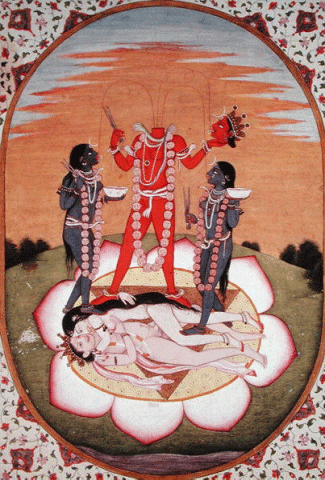 A Kangra painting (c. 1800 CE) of Chhinnamasta.
A Kangra painting (c. 1800 CE) of Chhinnamasta.
Yet the mystery remains as to why this particular drama, with its three female protagonists, was adopted into Tantric Buddhist meditative practices. We can see only two possible explanations for this. Firstly, that it represents an attempt by Vajrayana to incorporate within its own system every sacrificial magic element, regardless how bizarre, and even if it originated among the followers of a matriarchal cult. By appropriating the absolutely foreign, the yogi all the more conspicuously demonstrates his omnipotence. Since he is convinced of his ability to — in the final instance — play all gender roles himself and since he also believes himself a lord over life and death, he thus also regards himself as the master of this Chinnamunda “female ritual”. The second possibility is that the self-sacrifice of the goddess functions as a veiled reference to the “tantric female sacrifice” performed by the yogi, which is nonetheless capable of being understood by the initiated. [2]
SummaryThe broad distribution of human sacrifice in nearly all cultures of the world has for years occasioned a many-sided discussion among anthropologists and psychologist of the most varied persuasions as to the social function and meaning of the “sacrificium humanum”.
In this, reference has repeatedly been made to the double-meaning of the sacrificial act, which simultaneously performs both a destructive and a regulative function in the social order. The classic example for this is the sacrifice of the so-called “scapegoat”. In this case, the members of a community make use of magical gestures and spells to transfer all of their faults and impurities onto one particular person who is then killed. Through the destruction of the victim the negative features of the society are also obliterated. The psychologist Otto Rank sees the motivation for such a transference magic in, finally, the individual’s fear of death. (quoted by Wilber, 1990, p. 176).
Another sacrificial gnosis, particularly predominant in matriarchal cults presupposes that fertility can be generated through subjecting a person to a violent death or bleeding them to death. Processes from the world of vegetative nature, in which plants die back every year in order to return in spring, are simulated. In this view, death and life stand in a necessary relation to one another; death brings forth life.
A relation between fertility and human sacrifice is also formed in the ancient Indian culture of the Vedas. The earth and the life it supports, the entire universe in fact, were formed, according to the Vedic myth of origin, by the independent self-dismemberment of the holy adamic figure Prajapati. His various limbs and organs formed the building blocks of our world. But these lay unlinked and randomly scattered until the priests (the Brahmans) came and wisely recombined them through the constant performance of sacrificial rites. Via the sacrifices, the Brahmans guaranteed that the cosmos remained stable, and that gave them enormous social power.
All these aspects may, at least in general, contribute to the “tantric female sacrifice”, but the central factors are the two elements already mentioned:
The destruction of the feminine as a symbol of the highest illusion (Hinayana and Mahayana Buddhism)
The sacrifice of the woman in order to absorb her gynergy (Tantrayana).
Let us close this chapter by once again summing up why the female sacrifice is essential for the tantric rite: Everything which opposes a detachment from this world, which is characterized by suffering and death, all the obscuring of Maya, the entire deception of samsara is the shameful work of woman. Her liquidation as an autonomous entity brings to nothing this world of appearances of ours. In the tantric logic of inversion, only transcending the feminine can lead to enlightenment and liberation from the hell of rebirth. It alone promises eternal life. The yogi may thus call himself a “hero” (vira), because he had the courage and the high arts needed to absorb the most destructive and most base being in the universe within himself, in order not just to render it harmless but to also transform it into positive energy for the benefit of all beings.
This “superhuman” victory over the “female disaster” convinced the Tantrics that the seed for a radical inversion into the positive is also hidden in all other negative deeds, substances, and individuals. The impure, the evil, and the criminal are thus the raw material from which the Vajra master tries to distill the pure, the good, and the holy.--
The Shadow of the Dalai Lama: Sexuality, Magic and Politics in Tibetan Buddhism, by Victor and Victoria Trimondi 











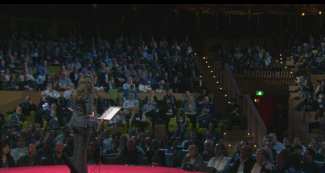

























_small.gif)








































